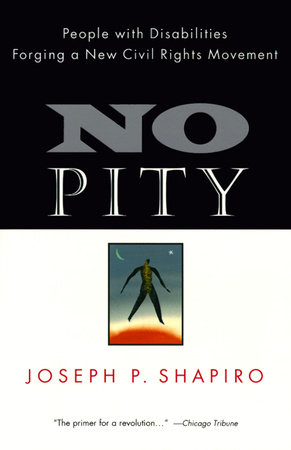
Author: Joseph P. Shapiro
Topics: Handicapped Civil Rights, Discrimination against the Handicapped, Government Policy, History of Individuals with Disabilities in the US
Summary
Anyone can face disability from a sudden accident or disease at any point. This frightening and humbling notion that we’re all “vulnerable to this misfortune” colors our attitude towards the disabled, even if we don’t explicitly recognize it. No Pity confronts this mind frame, chronicling the formation of the fight for disabled civil rights in the United States while targeting the political and social issues that still need resolution within our communities. The movement is simple enough: no pity towards the disabled or tragedy in disability; that is what oppresses. “Other people’s attitudes, not one’s disability, were the biggest barriers.” Society’s myths, fears, and stereotypes often make being disabled difficult. The main aim of people with disabilities participating in the movement is to claim their disability and feel okay about it. While understanding how society treats them is part of the experience, in no way does it need to be settled for. “Disability only becomes a tragedy for me when society fails to provide the things we need to lead our lives- job opportunities or barrier-free buildings, for example,” disability rights activist Judy Heumann sharply summarizes.
Told through a combination of personal experiences, interviews, and the narration of the lives of several disability rights activists, No Pity unflinchingly chronicles this fight for equality. Ed Roberts, one such activist, is introduced in chapter two. He founded the creation of the PDSP, or the Physically Disabled Students Program, the first of its kind at Berkeley College. PDSP allowed the college experience to become more accessible to students needing iron lungs, wheelchairs, and other medical support to attend classes. Movements like this encouraged offshoots to form, such as the CIL or Center for Independent Living, which adopted a similar format to the dormitories created at Berkeley so people with disabilities could live comfortably outside institutions, hospitals, or nursing homes. The Education of All Handicapped Children Act and Section 504: The Rehabilitation Act were also being fostered around the time of Berkeley’s advances in equality, making it illegal to deny someone an education or job based solely on being “handicapped.” These policy advances paved the way for the momentous Americans with Disabilities Act, which prohibits discrimination based on disability in all services, programs, and activities provided to the public by state and local governments.
No Pity also covers some unique subsects of disabled culture. Chapter three takes a deep dive into the history of ASL as a unique language with its cultural implications. Chapter seven explores the evolution of the wheelchair and the freedom lighter, flashier models such as the “screaming neon wheelchair” invented by Marilyn Hamilton. The remaining chapters focus intensely on how to give opportunities for independence and self-advocacy to those with disabilities, who often find themselves trapped in situations where they are denied the opportunity to make choices for themselves or never given the support to live in the world as an active participant. “People with disabilities want neither pity-ridden paternalism nor overblown admiration. They insist simply on common respect and the opportunity to build bonds to their communities as fully accepted participants in everyday life.” By expanding knowledge of this movement and the equality sought, we can all work together to create a society full of equal opportunity and choice, which is hospitable to everyone.
You’ll Love This Book If
If you’re looking for a comprehensive history of the civil rights movement for those with disabilities through the lens of activists’ lives. For those seeking understanding, the first-person narration of life experiences with disabilities provides powerful and painful illumination of the realities of life with disabilities.
This book was published in 1994 after significant progress was made in the fight for disabled civil rights. Still, if you’re looking for a comprehensive look at current policies and practices for the disabled dating after 1994 through 2022, this book might not be for you.
Trigger Warning
This book depicts children and adults with disabilities being neglected, mistreated, sexually abused, and assaulted. The topic of abortion and the choice to abort children with disabilities is referenced, which could be triggering to some readers. Graphic descriptions of self-injury, malpractice, and mistreatment in institutionalization, nursing home care, and the care of personal assistants and attendants are also present.
